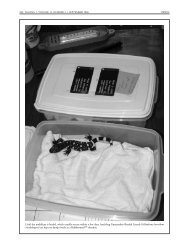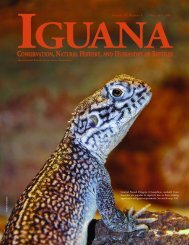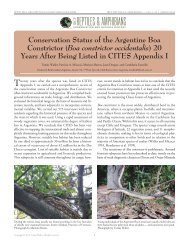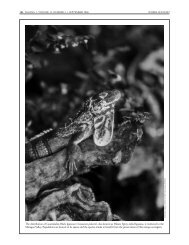Spiny-tailed Iguanas (Ctenosaura similis) in Venezuela
Spiny-tailed Iguanas (Ctenosaura similis) in Venezuela
Spiny-tailed Iguanas (Ctenosaura similis) in Venezuela
Create successful ePaper yourself
Turn your PDF publications into a flip-book with our unique Google optimized e-Paper software.
GUATEMALAN BLACK IGUANA<br />
Search<strong>in</strong>g for <strong>Ctenosaura</strong> palearis <strong>in</strong>side a hollow trunk us<strong>in</strong>g a bore<br />
scope funded by the San Diego Zoo.<br />
nels <strong>in</strong> which they lay their eggs. Nests were <strong>in</strong> banks of dry<br />
streams and gullies and <strong>in</strong> sandy patches with<strong>in</strong> the dry forest.<br />
Six to twelve eggs are deposited from late March to late April.<br />
Eggs beg<strong>in</strong> hatch<strong>in</strong>g <strong>in</strong> late May, which co<strong>in</strong>cides with the<br />
beg<strong>in</strong>n<strong>in</strong>g of the ra<strong>in</strong>y season. Both males and females lose<br />
weight dur<strong>in</strong>g the reproductive season. We also found evidence<br />
that Guatemalan Beaded Lizards (Heloderma horridum charlesbogerti)<br />
are predators of C. palearis nests.<br />
Discussion<br />
Traditional Use<br />
Local villagers use C. palearis primarily as a prote<strong>in</strong> source. The<br />
species is heavily hunted <strong>in</strong> some areas, especially dur<strong>in</strong>g the<br />
breed<strong>in</strong>g season when the kill<strong>in</strong>g of gravid females has a substantial<br />
impact on the survival and viability of wild populations.<br />
Although iguanas have been eaten by humans for many<br />
generations, the impact is exacerbated today by habitat loss, illegal<br />
trade, and non-susta<strong>in</strong>able hunt<strong>in</strong>g practices. Habitat loss is<br />
due primarily to the <strong>in</strong>creas<strong>in</strong>g amount of land used for watermelon<br />
cultivation and the construction of new residential zones<br />
IGUANA • VOLUME 15, NUMBER 3 • SEPTEMBER 2008 147<br />
with<strong>in</strong> the valley. Local people say they have seen a dramatic<br />
dim<strong>in</strong>ution <strong>in</strong> wild iguana populations compared to 20 years ago.<br />
Hunt<strong>in</strong>g of gravid female iguanas is non-susta<strong>in</strong>able. Animals<br />
are consumed or hunters make an <strong>in</strong>cision to remove eggs, sew<br />
the iguanas up and let them go free. These <strong>in</strong>dividuals soon die <strong>in</strong><br />
the wild from bacterial <strong>in</strong>fections and <strong>in</strong>ternal hemorrhages.<br />
Illegal trade is prov<strong>in</strong>g to be a much more serious threat to<br />
the species than hunt<strong>in</strong>g. People who catch iguanas for meat<br />
usually catch six a month, while illegal traders often catch 50–60<br />
iguanas a month. Web and market surveys have shown that this<br />
species is sold <strong>in</strong> countries such as Greece, Germany, and the<br />
United States for an average price of $25.00 per <strong>in</strong>dividual. All<br />
<strong>Ctenosaura</strong> palearis sold outside Guatemala are illegal, as governmental<br />
biodiversity authorities <strong>in</strong> Guatemala have not issued any<br />
export permit for this species (CONAP 2008).<br />
These factors seriously affect the viability of the extant populations<br />
of C. palearis. Subsistence hunt<strong>in</strong>g as currently practiced<br />
may cause long-term depletion of this species unless we develop<br />
a susta<strong>in</strong>able extraction plan accompanied by legislation that regulates<br />
the use of this species for such purposes. Farm<strong>in</strong>g iguanas<br />
may be a way of meet<strong>in</strong>g the demand for iguana meat and eggs<br />
with<strong>in</strong> the valley. The more important threat at this time is the<br />
illegal trade of this species on the <strong>in</strong>ternational market. This may<br />
be dim<strong>in</strong>ished by <strong>in</strong>corporat<strong>in</strong>g C. palearis <strong>in</strong> Appendix II of the<br />
CITES convention. This iguana species certa<strong>in</strong>ly meets the criteria<br />
for <strong>in</strong>clusion.<br />
Habitat Characterization<br />
Habitat selection may be determ<strong>in</strong>ed by the availability of food<br />
resources or the availability of trees provid<strong>in</strong>g suitable refugia<br />
and bask<strong>in</strong>g sites (Valenzuela 1981, Lara-Lopez and Gonzales<br />
2002). Our results <strong>in</strong>dicate that species composition, average<br />
height, and DBH of trees are important factors <strong>in</strong> habitat selection<br />
by C. palearis.<br />
The tallest trees provide appropriate sites for males’ territorial<br />
displays (Werner 1987). They also are used for thermoregulation.<br />
Trunk diameter is an important factor <strong>in</strong> shelter selection,<br />
ma<strong>in</strong>ly for the adults that require larger cavities for use as refugia.<br />
For example, <strong>in</strong> the cactus Stenocereus pru<strong>in</strong>osus, the species<br />
most frequently used by C. palearis as shelters, we have found<br />
Evidence of the feed<strong>in</strong>g habits of <strong>Ctenosaura</strong> palearis (from left to right): Fruits of the cactus Stenocerus pru<strong>in</strong>osus, iguana with seeds adher<strong>in</strong>g to the<br />
throat, and fruit pulp of S. pru<strong>in</strong>osus sta<strong>in</strong><strong>in</strong>g the throat of another <strong>in</strong>dividual.








